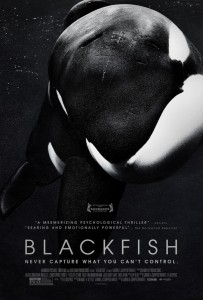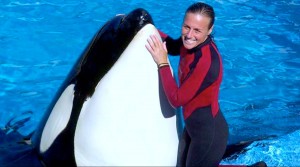As seen in class there are two kinds of sustainability marketing objectives: change what people do and change the way they see the world. The documentary Blackfish premiered at the 2013 Sundance film festival achieved both goals.
SeaWorld is a company with many marine mammal theme parks in the United States. Killer whales and dolphins among others are kept in captivity as trained show performers in these parks. Blackfish is a documentary by director-producer Gabriela Cowperthwaite that follows the controversial captivity of killer whales. By telling the story of Tilikum, a performing killer whale responsible for several human deaths while in captivity at SeaWorld, the documentary unveils the dangers of keeping orcas in captivity for both whales and humans. In 2010 trainer Dawn Brancheau died during a show at SeaWorld. Her death lead to a series of investigations about the risks and psychological effects of keeping orcas in captivity. The documentary is firmly against keeping killer whales in captivity and highly critical about the multi-billion dollar sea-park industry.
In my opinion Blackfish cannot be seen merely as a documentary. Director Gabriela Cowperthwaite was able to deliver a really strong message. Shortly after the documentary was premiered at the Sundance film festival we could already see the so-called “Blackfish Effect”. People’s opinion (mine included) regarding killer whales in captivity changed drastically because of Blackfish. I firmly believe Cowperthwaite’s documentary changed the way we see the world. Surely mine did. I have to admit I was never a great defendant of animal rights and I had nothing against theme parks like SeaWorld before. Blackfish certainly changed that. John Racanelli, chief executive officer of the National Aquarium, said “baby boomers grew up on Flipper, but millennials grew up on Free Willy”. Now we care about these animals being treated more humanely and we are interested in their welfare. We have evolved as an audience and we want to change how things are being done. Blackfish exposed some uncomfortable truths and people have reacted. SeaWorld is not the first company to suffer from public opposition and will not be the last one.
“I hope this movement grows beyond the SeaWorld discussion. Maybe if we continue to consider how someone else is experiencing our footprint, we’ll walk more softly in general. And that’d be a win for the planet.” – Gabriela Cowperthwaite
References
http://www.blackfishmovie.com/about/
http://www.telegraph.co.uk/film/blackfish/seaworld-orca-whales-finding-dory/
http://www.theguardian.com/commentisfree/2015/aug/20/killer-whales-not-suitable-captivity-seaworld
Blackfish Poster (Left). Dawn Brancheau with Tilikum (Right)


Just this past weekend, I saw this documentary featured on Netflix and made a mental note to go back and watch it later. As I learn more about sustainable practices in business, I find myself being drawn to the documentaries that seek to uncover the harsh impacts that humans have made on the planet. Although I know that holding animals in captivity isn’t a sustainable practice, as it significantly alters their psychological behavior, I myself am guilty of supporting these multi-billion dollar businesses that profit off of animal exploitation (ie: I have visited petting zoos while on vacation and “swam with the dolphins” at Hawaii’s SeaLife Park when I was 12).
While the millennial generation is striving to decrease its environmental footprint and negative impact on biodiversity, it is important to note that even newer, innovative practices can wreak havoc on an ecosystem. For instance, tidal barrages (form of renewable energy) have: led to an increase in fish mortality as a result of their collision with the turbine blades, altered marine migration patterns and have trapped large mammals inside the basins for weeks. Ultimately, I think it is important for us to recognize that even the best intentions can have unintended, adverse effects on the environment and should be taken into consideration when we develop more sustainable options- especially for animals in captivity.
For information of tidal barrages: http://www.energybc.ca/profiles/tidal.html